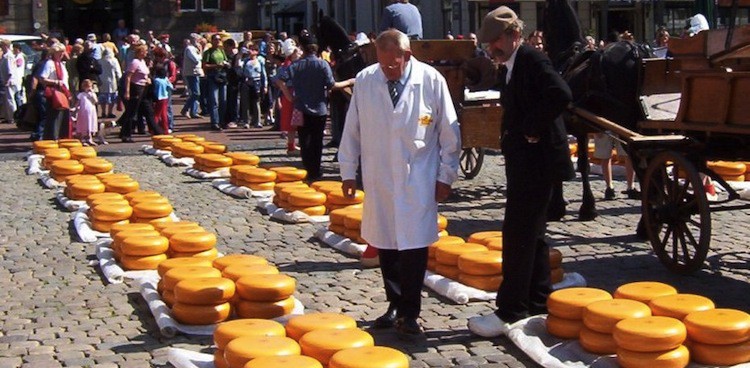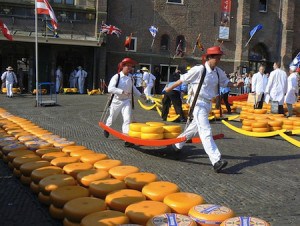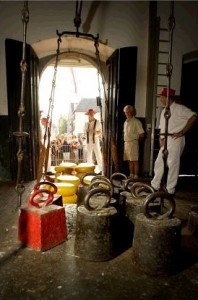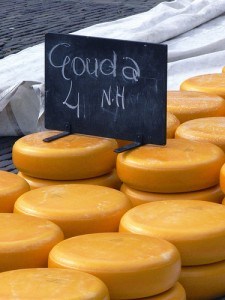
In this blog series, Molly will be (virtually) traveling around the globe to explore the way cheeses are enjoyed and incorporated into different cuisines. Some of these cheeses and methods might seem familiar, while others might be completely new to you. Last week, we talked about Italy, and how cheese permeates every aspect of the food there. Winston was the winner of a free issue of culture – read on to find out how you can win a copy, too! Get more stamps on your cheese passport and join us for a historical and cultural adventure!
The Netherlands is famous for its Gouda, which many of us might recognize as the small snack-sized cheese encased in red wax. Gouda (named for the town where it was historically traded rather than where it was produced) is a broad term for the style of cheese commonly produced in the Netherlands. Since Gouda can be made from raw or pasteurized milk, can have a natural or waxed rind, and can range in size 1 to 176 pound wheels, it’s helpful to think of it as a style of cheeses rather than a specific cheese. Gouda can be aged up to five years, and – at its best – this aging produces a butterscotch flavor and crunchy crystallization. Though Gouda is traditionally made from cow’s milk, many producers in Holland and around the world are making Goudas with not just cow’s, but also goat’s or sheep’s milk. Gouda’s signature characteristic is its flattened wheel shape.
Holland has other cheeses to offer besides Gouda. Edam, known to most people outside the country as the wax-coated balls served at holiday parties, is actually much harder and sharper in flavor than the mild, semi-soft cheese most of us are used to in the US. Since this cheese was sturdy and resistant to spoilage, some scholars believe it was the most popular cheese between the 14th and 18th centuries, when the Dutch dominated international trade. Boerenkaas is similar to Gouda, but its name is regulated by its origin, meaning to deserve the name, it must be made from raw milk from a small-scale farm.
The importance of cheese in the culture and the commerce of the Netherlands is apparent in the history of the cheese market. Traditionally, when a farmer brought cheese to the market, teams of cheese porters, identified by brightly colored straw hats, carried the cheese in barrows, usually weighing about 160 kilograms, or close to 350 pounds! Buyers sampled the cheese, using a special slicer called a kaasschaaf. The price would be decided through a bargaining ritual known as handjeklap. Both the buyer and seller would shout a price for a kilogram of cheese and clap each other’s hands. The last clap closed the deal in the sale – see it in action in this video.

Dutch cheese porters at the market | Photo credit: Image courtesy of Traveller Notes
There are a variety of cheese markets in the Netherlands where these colorful rituals and traditions are preserved, though most are only open during the summer months. The city of Alkmaar is well-known for its traditional cheese market, which is set up to mimic the operation of the market during the post-medieval period. The market opens with the ringing of a bell, and visitors can watch the handjeklap and the weighing of cheeses on the cheese scales in this 400 year old market.

The cheese scales at Alkmaar | Photo credit: image courtesy of Alkmaar Cheese Market
At the Edam market, horse-drawn carriages and boats carry the cheese to be weighed. The Gouda cheese market, located in the namesake town of the iconic cheese, offers tourists a chance to have their weight measured in cheese or a visit to the Cheese Museum. Cheese farmers go to the Woerden cheese market every Wednesday throughout the year to sell their cheese, and since it is a operational commercial market, there is not as much spectacle or fanfare as the others.
Proper Dutch cheese is “creamy with a hint of sourness” according to award-winning cheesemaker Henri Willig, which is a characteristic many consumers prefer to other European cheeses. If you are lucky enough to find yourself in the Netherlands, the “cheese trail” is a great chance to experience the flavorful cheeses that often are not exported to the United States, though some specialty cheese shops will carry artisanal and aged varieties.
What’s your favorite way to eat Gouda? Do you have any favorite Dutch cheeses? Tell us about it in the comments below for a chance to win a copy of our summer issue! Comments must be posted by 11:59 p.m. EDT on Tuesday, July 22, 2014 to be eligible to win. So comment today and stay tuned for next week’s post!
Photo Credit: Featured image courtesy of Wikipedia




Dutch will continue to dominate cheese market so it seems
Mmmm aged Gouda just by itself is marvelous